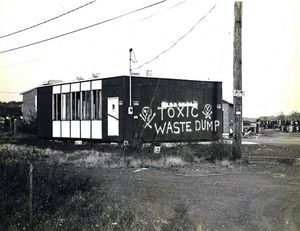2008.08.26 – Why are we getting cancer?
http://www.tnonline.com/node/352203
August 26, 2008
Why are we getting cancer?
$262K fed study will try to pinpoint cause; Superfund sites not ruled out
By DONALD R. SERFASS dserfass@tnonline.com

SPECIAL TO THE TIMES NEWS This photo, taken by Greg Machay, Tamaqua, in 1970, shows the McAdoo Associates Superfund Site and some of the hundreds or possibly thousands of barrels deposited at the former minesite located just north of Tamaqua’s Still Creek Reservoir. Machay turned over the photo to TIMES NEWS journalist Donald Serfass in 2006, just weeks before Machay passed away from cancer at age 58.
BUTLER TOWNSHIP There is a “significant” cluster of a rare blood cancer in our area and the federal government will spend $262,000 to investigate the cause.
At a meeting Monday at Genetti’s Best Western Motor Lodge, Hazleton, to present the “Final Report to the Community,” federal officials said at least 33 confirmed cases of polycythemia vera (PV) have been identified in Carbon, Schuylkill and Luzerne counties. It appears to be the most pronounced cluster in a tri-county area and seems to be centered around the McAdoo Associates Superfund Site. The site is one of five Superfund locations in the general area.
“The health of my constituents is of utmost importance and I remain concerned about the reports of a cancer cluster in northeastern Pennsylvania,” said U.S. Sen. Arlen Specter in a prepared statement. “It is clear that more research is necessary to pinpoint the reasons for this cluster, including whether environmental contaminants are a factor, and this funding will help to accomplish what today’s panel of experts recommends.” Specter was not on hand for the session but sent representatives from his office.
Specter, a Ranking Member of the House Appropriations Subcommittee on Labor, Health, Human Services, and Education, said the fund will target the polycythemia vera cluster. The determination was made after consultation with the PA Department of Health and Drexel University.
The funding is included in the Fiscal Year 2009 Labor, Health and Human Services, and Education Appropriations bill approved in July. It must be agreed upon by the full Senate, the House, and the President of the U. S. before the funding is final.
At Monday’s public meeting, Dr. Vince Seaman, research and epidemiologist in the Health Investigations Branch of the Division of Health Studies for the Agency for Toxic Substances and Disease Registry (ATSDR), said coal mining is an unlikely cause of PV. But not the same can be said of CoGen plants operating in the area between 1988-1992 and the various Superfund sites.
“Are we at risk? We don’t know because we can’t answer it,” said Seaman.
Specter has closely monitored the occurrence of polycythemia vera in the community and visited the McAdoo site two years ago. After learning of the concerns, he requested that the Centers for Disease Control and Prevention (CDC) assist the PA Department of Health in studying the community’s health problems.
On Oct. 5, 2006, Specter stood on the hilltop just south of McAdoo, at the location of the McAdoo Associates Superfund site, and said the CDC and health department would partner to perform a statistical analysis of the region’s health data.
